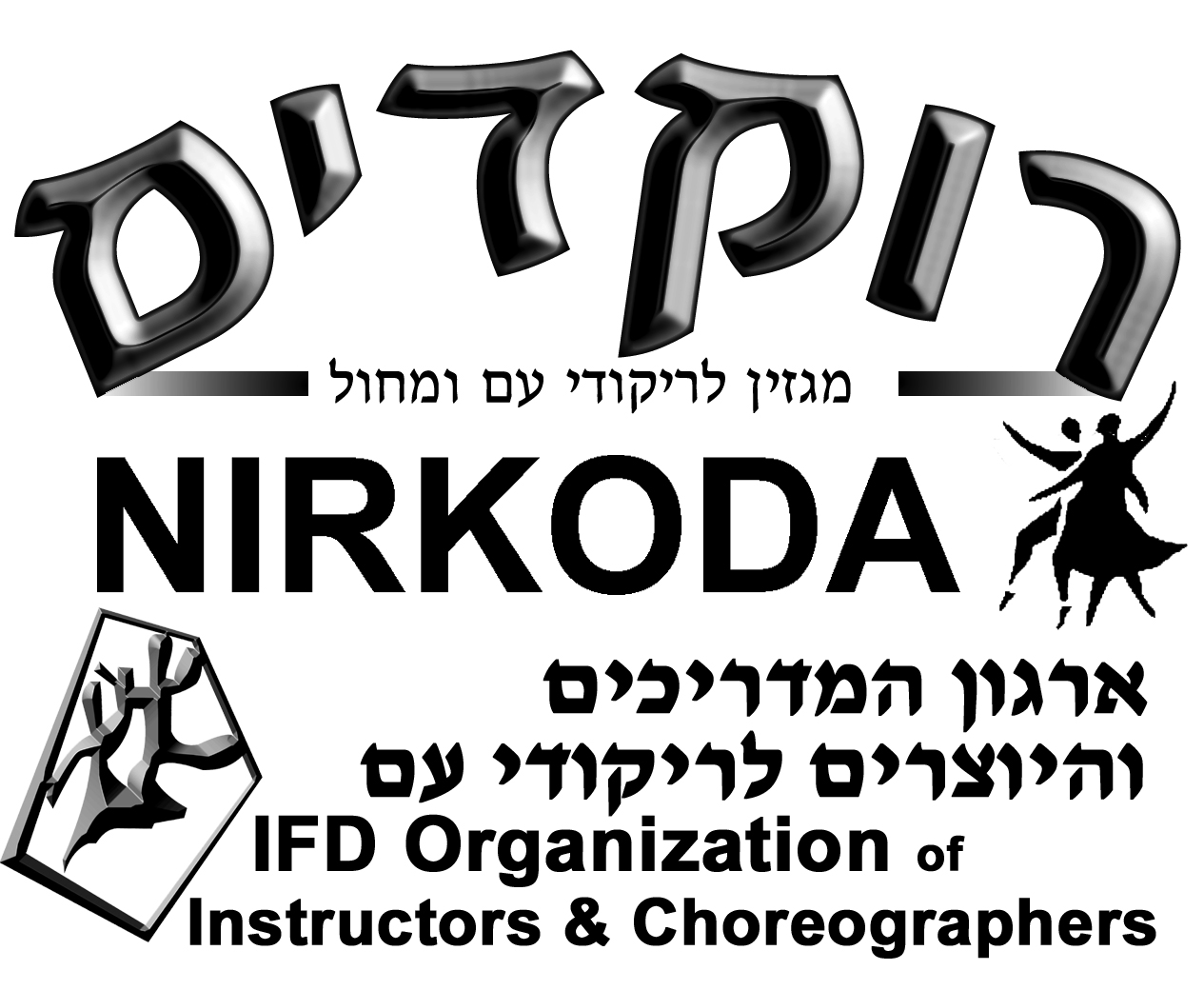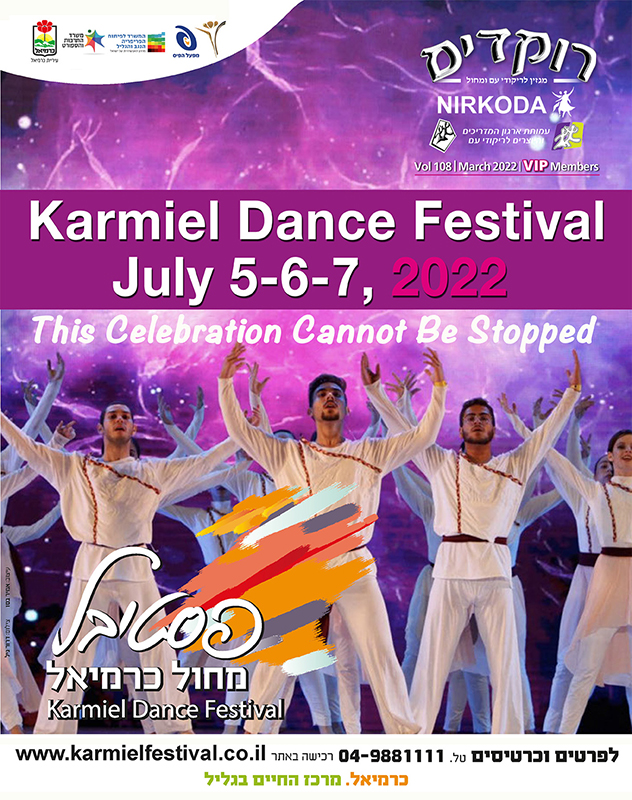- Home
- Rokdim Nirkoda 108
- Le’Ha’amin – To Believe
I’m in my 40s. I’ve been dancing since I was about 13 years old; I’m a dance leader and facilitator of dance workshops around the world and a choreographer of dances for about 30 years…
I live in Melbourne, Australia and run three weekly classes through the Nirkoda-Melbourne Association. Once every two years, the association holds” Nirkoda Camp” in which the choreographers of dances from Israel participate.
While walking around the Ashdod beach as a youngster, I was drawn to folk dance and came across the free municipality harkadot (dance sessions) on the beach. I was fascinated by the combination of my very favorite Hebrew music along with a group of dancers performing the exact same steps as well as the fact that each song has its own different steps. I decided that I too wanted to take part in it; (as a young child, until then, I had been active in ballroom dance classes).
I started to attend beginner classes in Ashdod organized by the Didi Dosh z”l and Jack Ochayon. Slowly I began to learn and to fit in. I was thirsty to know and learn more and more, until I discovered that there was a folk dance shop at 10 Ha’Arba’a Street in Tel Aviv. Once in a while, I would go there and buy videotapes, so I could learn more and more … The first tape I purchased was of debka dances.
In the early 1990’s, Gadi Bitton opened a chug in Ashdod and of course, I also joined this class. At the time, Gadi offered me to join him, as his helper, and thus learn and experience the role of a dance leader.
I was at his side for three years and learned a lot. I fell in love “with the craft” and a small spark ignited in me that began to burn within me – to choreograph my own dances.
In 1997, I choreographed my first dance – Yesh Li Koach L’Ham’shech – I Have Strength To Continue (to the song of Boaz Sharabi) under the guidance and direction of Gadi.
In 2000, I set out on my own and started to lead dancing in schools, afternoon classes and a small evening class in Ashdod. In 2009 I joined my good friend, Sagi Azran, and led dancing in a chug in Yehud. That year, I was one of the founders of “Ruach Ne’urim – Spirit of Youth” – a group that advocated bringing the young and the young at heart from all over the country into the folk dance movement; we held various events and workshops aimed at quickly integrating young people into folk dance with the repertoire and mainly, how to make them stay for the long term, what’s called “the creation of the future generation”.
In 2010, I went to a camp in Melbourne, Australia. I was “turned on” by the place and I decided to remain and live there. To this day I am active in the local folk dance movement in Melbourne, through the Nirkoda Association.
My ideology as a dance leader – a combination of all styles from all times and at all levels. All the time, renewing and creating interest, while preserving and respecting the nostalgia dances we grew up on.
As a choreographer, I try to choreograph dances that will be relatively simple and “doable” for everyone, while creating an interesting part that has not been seen before, in order to differentiate that dance from the other existing dances and that would still be interesting for the dance community.
I especially enjoy when the song “guides” me through with words that can be translated into movement like “hug you”, “run” “pray” and more….
To date I have choreographed over 80 dances. I enjoy collaborating with other choreographers – in the sense of combining ideas and learning from one another.
The last period, when we danced less and were at home more, was a time that brought many thoughts to me in the creative area. I lingered a lot on each and every song and searched for the “right step” without compromising; I can no longer wait for it to be behind us and share the new dances I have choreographed.
See you on the dance floor!!!!
About the dance
I received the song “Le’Ha’amin – To Believe” during the weekend prior to its release along with a recommendation that it would be a quiet, emotional and touching song. During the weekends, I usually try not to touch folk dance but to dedicate my time to the family. For sure, after releasing a few quiet dances, my desire was to do more upbeat and lively dances. After realizing that the singer of the song for, Doli & Penn (the songwriters and composers) this time, was my favorite singer, Idan Raichel, I decided not to wait and immediately listened to him sing and see if I would connect to it in terms of choreographing a dance.
Immediately upon my first hearing it, I was captivated by the perfect performance of Idan Raichel that also blended perfectly with the moving melody and lyrics that symbolize hope, especially during the difficult time we had (and are still going through) with the virus and everything surrounding it.
Within a few minutes, I was successful in putting together a simple dance pattern that flowed. My first priority was to choreograph a dance designed for all levels of dancers and one where the steps would “not interfere” with the flow of the song.
As I delved deeper into the lyrics, to my delight, I found that there were phrases in the song that can be translated into movements – which to me, as a dance choreographer, is very aesthetic and makes the dance even more special. In the original dance pattern that I choreographed, I incorporated movements until I was satisfied with the final result.
For example:
– In the first part, in the phrase. “he is always waiting” – the dance flow stops and waits by performing a transfer of weight in place, before immediately preceding to the next part.
– At the beginning of the chorus – “feel without touching” – the hands come out with a pause, as if wanting to “touch”….
– During the chorus – “Hugged tightly in the hands” – The hands close diagonally to the chest in a hugging motion, before extending to finish the part.
To my delight, the final result was received with affection and appreciation in most harkadot (dance sessions) in Israel and the dance even spread around the world at dance sessions in South America, the United States, Europe and more ….
Le’Ha’amin – To Believe
Lyrics: Dolev “Doli” Ram and Penn Hazut
Composers: Dolev Ram and Penn Hazut
Singers: Idan Raichel, Dolev Ram, Penn Hazut
Everything that was here will change from tomorrow
Time will still repair everything that has already been broken and remains
There are those who keep the good near us
He is always waiting
Everything that was here will change from tomorrow
If we try
Just believe without knowing
To feel without touching
To talk with your eyes
Even when I have nothing more to say
Liberate the moment
It is natural to be afraid of nature
Embrace tightly with your hands
Every moment before it’s over
Everything that was here will change from tomorrow
Time will still repair everything that has already been broken and finished
All the prayers, the miracles in our lives
Connect to this moment
Everything that was here will change from tomorrow
If we try
Just believe without knowing
To feel without touching
To talk with your eyes
Even when I have nothing more to say
Liberate the moment
It is natural to be afraid of nature
Embrace tightly in the hands
Every moment before it’s over
The dance Le’Ha’amin (S.E.):
Meter: 4/4
Formation: Circle
Structure: one verse, two parts
Part A Hands free. Face and move CCW.
1-4 Begin with R: three steps forward: R, L, R; brush L fwd while raising both arms up.
5-8 Step L fwd; While lowering arms: step R back, step L back and lift Rt. knee; hold.
9-12 Step back on R, step L to left side to face center, cross R over L, step L back in place.
13-16 Full turn right on the line of the circle with two steps: R, L; sway: R-L.
17-19 Moving CCW on the line of the circle: step R to rt., cross L behind R, step R to rt. turning to the rt. to face out of center (back is to center).
20-22 Continue moving CCW: Step L to left, cross R behind L, step L to left turning to the left to end facing center.
(Note: counts 19-22 are like the beginning of the dance, “Eretz Eretz”.)
23-24 Sway: R, L.
25-28 Cross R over L to face CW and raise Rt. arm upwards, hold, step back on L lowering arm, step R to rt. to face center.
29-32 Cross L over R, hold; Moving fwd CCW on the line of the circle: Turn rt. with two steps R,L.
33-64 Repeat Part A, counts 1-32.
65-68 Face center. Sway: R, L. Close R next two L while clapping hands together in front of chest.
Part B Face center; Move CCW.
1-4 Sway: R,L,R while raising arms overhead (fwd, up and out to the sides) in a circular motion, hold.
5-8 Moving CCW: Cross L behind R, step R to right side, cross L over R, pivot left on L to end facing CW with right shoulder to center.
9-12 Two steps fwd: R,L and pivot on L to the rt. to end facing CCW (left shoulder to center); sway R to rt. while extending arms to rt. side (away from center), hold.
13-16 Full turn and a quarter left towards center of the circle with three steps: L,R,L. Hold.
17-20 Three steps fwd towards center of the circle beginning with R and pivot on rt. ½ turn to end facing out of center (back is to center). Hold.
21-24 Three steps bwd (continuing toward center): L,R,L while bringing hands in front of chest in a “hugging” motion. Hold.
25-28 Two steps forward moving out of center: R, L fwd; step fwd on R and pivot 1/2 turn left to face center; step L to left.
29-32 Cross R over L to left; step back on L in place; moving on the line of the circle 1&1/4 turn rt. with two steps: R,L.
33-64 Repeat Part B counts 1-32.
Ending – after 2nd time through the dance.
1-4 Repeat Part A counts 1-4.
5-8 Tcherkessia step: step fwd onto L, rock back onto R in place, step bwd onto L, rock fwd onto R.
9-10 Step L fwd, pivot on L to left to face center.
11-12 Close R next to L with knees slightly bent while crossing arms in front of body and snapping fingers. Hold.
Dance notation by Ruth Schoenberg and Ruth Goodman









Comments
התראות